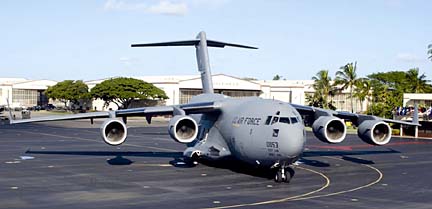
Eight C-17 jet cargo transports, like this one pictured in front of Hickam Air Force Base's operations center, will be stationed in Hawaii. The first C-17 is expected to arrive in February.
Air Force site bad
for airport, state says
Both the Federal Aviation Administration and the state Transportation Department have recommended against using Kalaeloa as a training site for the Air Force C-17 jet transports because the Leeward site is too close to Honolulu Airport.
In particular, the state told the Air Force it is worried about the high volume of daily operations proposed as Air Force and Hawaii Air National Guard pilots practice short take-offs and landings -- a key feature of the heavy-duty cargo jets. The military plans to bring C-17s to Hawaii in February.
"We're not opposed to basing the C-17s at Hickam," transportation spokesman Scott Ishikawa said. "But we think the training would be better done at the other remote locations the Air Force is considering."
The other three are Barking Sands on Kauai's west side, an area adjacent to the Kona Airport and Marine Corps Base Hawaii at Kaneohe Bay. After examining more than 20 airfields here, the Air Force narrowed its choice to four.
"We are concerned because the Air Force's operations plan proposes 400 to 900 landings a day," Ishikawa said. "They are proposing a steep descent from 25,000 feet into Kalaeloa. That would slow down air traffic into Honolulu Airport."
Col. Raymond Torres, commander of the 15th Airlift Wing at Hickam Air Force Base, said the FAA believes the C-17s would cause problems for commercial airlines.
The C-17 jet cargo planes are one of the links in establishing a Stryker combat brigade at Schofield Barracks. The C-17 squadron, the first stationed outside the mainland, would be composed of 140 active Air Force and Hawaii Air National Guard personnel and based at Hickam. The first of eight 174-foot C-17s is expected to arrive in February.
The plane is designed to land and take off on runways as short as 3,000 feet. Training on short landing areas is crucial for pilots preparing for combat missions in places like Afghanistan and Iraq, Torres recently told reporters.
Besides being able to handle short take-offs and landings, C-17 pilots will need to practice landing approaches from random directions and spiral approaches from high overhead. Operations on the training site would take place at least once a day, averaging about four hours a day, Torres said.
That averages to about 16 landings in four hours, or one landing every 10 to 15 minutes, he said. Flight operations will occur at night and during the day.
An environmental assessment on C-17 runway sites should be completed by the end of the year.
— ADVERTISEMENTS —
— ADVERTISEMENTS —
